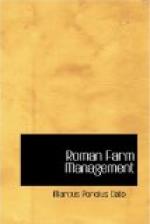“Those plough lands which are cultivated when they are miry are rendered useless for an entire year—they can be neither seeded nor harrowed nor hoed—but those which are worked when they are in the state which has been described as varia, remain sterile for three years on end. We should, therefore, follow a medium course and plough when the land neither lacks moisture nor yet is deep in marsh.”]
[Footnote 31: Columella (II, 13) justly says about manure, “Wherefore if it is, as it would seem to be, the thing of the greatest value to the farmer, I consider that it should be studied with the greatest care, especially since the ancient authors, while they have not altogether neglected it, have nevertheless discussed it with too little elaboration.” He goes on (II, 14) to lay down rules about the compost heap which should be written in letters of gold in every farm house.
“I appreciate that there are certain kinds of farms on which it is impossible to keep either live stock or birds, yet even in such places it is a lazy farmer who lacks manure: for he can collect leaves, rubbish from the hedge rows, and droppings from the high ways: without giving offence, and indeed earning gratitude, he can cut ferns from his neighbour’s land: and all these things he can mingle with the sweepings of the courtyard: he can dig a pit, like that we have counselled for the protection of stable manure, and there mix together ashes, sewage, and straw, and indeed every waste thing which is swept up on the place. But it is wise to bury a piece of oak wood in the midst of this compost, for that will prevent venomous snakes from lurking in it. This will suffice for a farm without live stock.”
One can see in Flanders today the happy land smiling its appreciation of farm management such as this, but what American farmer has yet learned this kind of conservation of his natural resources.]
[Footnote 32: The occupants of the motor cars which now roll so swiftly and so comfortably along the French national highway from Paris to Tours, through the pleasant pays de Beauce, can see this admirable and economical method of manuring still in practice. The sheep are folded and fed at night, under the watchful eye of the shepherd stretched at ease in his wheeled cabin, on the land which was ploughed the day before.]
[Footnote 33: These of course are all legumes. The intelligent farmer today sits under his shade tree and meditates comfortably upon the least expensive and most profitable labour on his farm, the countless millions of beneficent bacteria who, his willing slaves, are ceaselessly at work during hot weather forming root tubercles on his legumes, be it clover or cow peas, and so fixing for their lord the free atmospheric nitrogen contained in the soil. As Macaulay would say, “every school boy knows” now that leguminous root nodules are endotrophic mycorrhiza,—but the Romans did not! Nevertheless their empirical practice of soil improvement with legumes was quite as good as ours. Varro (I, 23) explains the Roman method of green manuring more fully than Cato. Columella (II, 13) insists further that if the hay is saved the stubble of legumes should be promptly ploughed for he says the roots will evaporate their own moisture and continue to pump the land of its fertility unless they are at once turned over.




